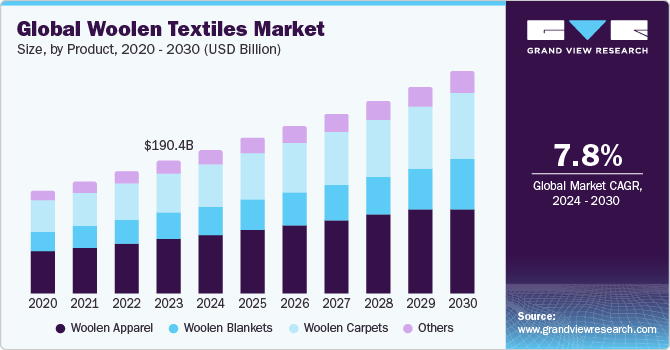Woolen Textiles Market Size & Trends
The global woolen textiles market size was valued at USD 190.4 billion in 2023 and is expected to grow at a compound annual growth rate (CAGR) of 7.8% from 2024 to 2030. The wool textile market is primarily driven by a growing consumer preference for sustainable and natural fibers. As awareness of environmental concerns rises, wool's biodegradability and renewable nature contribute to its popularity. Additionally, technological advancements in wool processing have enhanced its appeal, resulting in innovative and high-performance wool textiles. The fashion industry's increasing focus on eco-friendly and ethical practices further propels the demand for wool. Moreover, the inherent properties of wool, such as insulation, moisture-wicking, and durability, make it a favored choice in various applications. Rising disposable incomes, changing lifestyles, and a resurgence of interest in traditional and natural materials further stimulate the global wool textile market, ensuring a robust and sustainable trajectory.

The wool textile market witnessed a profound impact from the Covid-19 pandemic. Global lockdowns and supply chain disruptions led to a temporary downturn in manufacturing and distribution. With retail closures and economic uncertainties, consumer demand for non-essential items, including wool textiles, experienced a significant decline. The fashion industry, a major consumer of wool, faced challenges due to restricted gatherings and changing consumer priorities during the crisis. On a positive note, the pandemic heightened awareness of sustainability, fostering an increased interest in eco-friendly materials like wool. As economies gradually recover, the wool textile market is adapting to new consumer behaviors, emphasizing digital channels, and incorporating sustainability measures, positioning itself for resilience and growth in the post-pandemic landscape.
The global wool textile market is driven by a convergence of factors, with sustainability emerging as a paramount force. Growing environmental consciousness among consumers has fueled a preference for natural and biodegradable fibers like wool. The textile industry's commitment to eco-friendly practices, coupled with technological innovations in wool processing, has enhanced its appeal. Additionally, the versatile properties of wool, including insulation, moisture-wicking, and durability, contribute to its widespread adoption in various applications. The fashion industry's increasing focus on ethical sourcing and sustainable practices further amplifies the demand for wool textiles. As global consumers prioritize eco-conscious choices, the wool textile market stands as a beneficiary, aligning with evolving preferences and reinforcing its position in a sustainable and socially responsible global marketplace.
Wool Type Insights
Based on the wool type, the woolen textiles market is segmented into merino wool, lamb’s wool, cashmere wool, and others. The type of wool plays a pivotal role in driving the wool textile market. Fine wool, such as Merino, is prized for its softness and is often associated with luxury products. Medium-grade wool is versatile, finding applications in various textile products. Coarse wool, known for durability, is used in heavy-duty items like carpets. Consumer preferences for specific wool types are influenced by factors such as comfort, insulation, and intended use. The market's ability to offer a diverse range of wool types caters to a wide spectrum of consumer needs, driving demand and ensuring the industry's adaptability to varied market trends.
Sales Channel Insights
Based on sales channels, the woolen textiles market is segmented into retail stores and online stores. The retail stores and online stores segments are dual drivers of growth for the wool textile market. Retail stores provide a tactile and immersive shopping experience, particularly for consumers who value the feel and quality of wool products before purchasing. These physical outlets contribute to brand visibility and customer engagement. On the other hand, the booming trend of online stores capitalizes on the digital era, offering a convenient, accessible, and often diverse marketplace. E-commerce platforms enhance the global reach of woolen textiles, facilitating seamless transactions and providing consumers with a wide array of choices. The synergy between retail and online channels, leveraging both traditional and digital strategies, ensures a comprehensive market presence, appealing to diverse consumer preferences and fueling the overall growth of the wool textile industry.
Regional Insights
Asia Pacific dominated the market in 2023.In the Asia Pacific region, several factors contribute to the growth of the wool textile market. The region's burgeoning population, coupled with rising disposable incomes, propels demand for high-quality and sustainable textiles, including wool. Asia Pacific is a major manufacturing hub for textiles, and the availability of skilled labor contributes to efficient production processes. Moreover, the growing awareness of environmental sustainability aligns with the eco-friendly attributes of wool, fostering its adoption in the region. Rapid urbanization and changing lifestyles also drive the demand for diverse woolen products, from apparel to home textiles.
In North America, the wool textile market is influenced by a combination of factors. The region's emphasis on fashion trends and premium quality products supports the demand for fine wool textiles. The increasing preference for sustainable and ethically sourced materials aligns with wool's natural and renewable characteristics. Furthermore, the emphasis on outdoor activities and functional clothing enhances the market for wool, given its insulating and moisture-wicking properties. The region's mature retail infrastructure, both online and offline, provides a robust distribution channel for woolen textiles. Additionally, collaborations between fashion designers and wool producers contribute to the market's dynamism, creating innovative and fashionable wool products that resonate with North American consumers.
Competitive Insights
Key players operating in the market are The Woolmark Company, Dormeuil, Loro Piana, Reda, Vitale Barberis Canonico, Ermenegildo Zegna, Johnstons of Elgin, Fox Brothers & Co., Abraham Moon & Sons, Dugdale Bros & Co., Pendleton Woolen Mills, and Noble Biomaterials. The market participants are constantly working towards new product launches, and M&A activities, and other strategic alliances to gain new market avenues. The following are some instances of such initiatives.
-
In 2022, the Woolmark Company and Vitale Barberis Canonico formed a strategic alliance to develop new sustainable wool fabrics. This alliance would help the company increase awareness about wool products and their use in the fashion industry.
-
In 2021, Wool Partners International and Zhejiang Jinghong Group formed an alliance to improve the sustainability of the wool supply chain.












